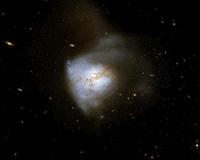 |
London, UK (SPX) Mar 23, 2010 Scientists Have Found A Massive Galaxy In The Early Universe Creating Stars Like Our Sun Up To 100 Times Faster Than The Modern-Day Milky Way. The Team Of International Researchers, Led By Durham University Scientist And Royal Astronomical Society Norman Lockyer Fellow Dr. Mark Swinbank, Described The Finding As Like Seeing "A Teenager Going Through A Growth Spurt". Due To The Amount Of Time It Takes Light To Reach Earth The Scientists Observed The Galaxy, Known As Smm J2135-0102, As It Would Have Appeared 10 Billion Years Ago - Just Three Billion Years After The Big Bang. They Found Four Discrete Star-Forming Regions Within The Galaxy And Each One Was More Than 100 Times Brighter Than Star-Forming Regions In The Milky Way Like The Orion Nebula Familiar To Amateur Astronomers. The Team Say Their Results, Published Online In The Prestigious Scientific Journal Nature, Suggest That Star Formation Was More Rapid And Vigorous In The Early Universe As Galaxies Went Through Periods Of Huge Growth. Their Findings, Funded In The Uk By The Ras And The Science And Technology Facilities Council, Provide A Unique Insight Into How Stars Formed In The Early Universe, The Scientists Added. Lead Author Dr. Mark Swinbank, Of The Institute For Computational Cosmology At Durham University Said: "This Galaxy Is Like A Teenager Going Through A Growth Spurt. "We Don'T Fully Understand Why The Stars Are Forming So Rapidly But Our Results Suggest That Stars Formed Much More Efficiently In The Early Universe Than They Do today. "Galaxies In The Early Universe Appear To Have Gone Through Rapid Growth And Stars Like Our Sun Formed Much More Quickly Than They Do today." The Scientists Estimate That The Observed Galaxy Is Producing Stars At A Rate Equivalent To 250 Suns Per Year. The Findings Support Earlier Research Led By Durham University. In 2009 Durham Scientists Found That The Galaxy Ms1358Arc, An Object So Far Away That We See It As It Appeared 12.5 Billion Years Ago, Was Forming Stars More Rapidly Than Expected. Smm J2135-0102 Was Found Using The Atacama Pathfinder Experiment (Apex) Telescope, Which Is Operated By The European Southern Observatory (Eso). Follow-Up Observations Were Carried Out By Combining The Natural Gravitational Lens Of Nearby Galaxies With The Powerful Submillimeter Array Telescope Based In Hawaii To Magnify The Galaxy Even Further. Dr. Swinbank Added: "The Magnification Reveals The Galaxy In Unprecedented Detail, Even Though It Is So Distant That Its Light Has Taken About 10 Billion Years To Reach Us. "In Follow-Up Observations With The Submillimeter Array Telescope We'Ve Been Able To Study The Clouds Where Stars Are Forming In The Galaxy With Great Precision." Carlos De Breuck, A Co-Author Of The Paper, From Eso, Said: "The Star Formation In This Galaxy'S Large Dust Clouds Is Unlike That In The Nearby Universe. "However, Our Observations Suggest That We Should Be Able To Use Underlying Physics From The Densest Cores In Nearby Galaxies To Understand Star Birth In These More Distant Galaxies."
Share This Article With Planet Earth
Related Links Institute for Computational Cosmology Green Bank Telescope Royal Astronomical Society Stellar Chemistry, The Universe And All Within It
 Sharpest View Ever Of Distant Star Factories
Sharpest View Ever Of Distant Star FactoriesBoston MA (SPX) Mar 22, 2010 Astronomers have combined a natural gravitational lens and a sophisticated telescope array to get the sharpest view ever of "star factories" in a galaxy over 10 billion light-years from Earth. They found that the distant galaxy, known as SMM J2135-0102, is making new stars 250 times faster than our Galaxy, the Milky Way. They also pinpointed four discrete star-forming regions within the ga ... read more |
|
| The content herein, unless otherwise known to be public domain, are Copyright 1995-2010 - SpaceDaily. AFP and UPI Wire Stories are copyright Agence France-Presse and United Press International. ESA Portal Reports are copyright European Space Agency. All NASA sourced material is public domain. Additional copyrights may apply in whole or part to other bona fide parties. Advertising does not imply endorsement,agreement or approval of any opinions, statements or information provided by SpaceDaily on any Web page published or hosted by SpaceDaily. Privacy Statement |